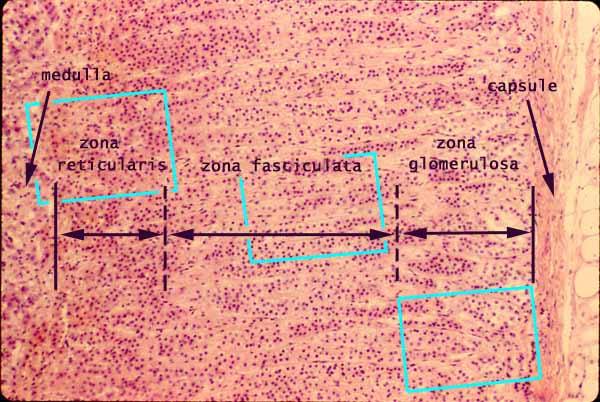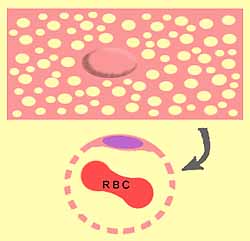Overview of Individual Endocrine Glands
(For additional detail, click on the name of the gland.)
 The
pituitary gland (or hypophysis)
consists of two distinct parts, the anterior pituitary (adenohypophysis)
and the posterior pituitary (neurohypophysis).
The
pituitary gland (or hypophysis)
consists of two distinct parts, the anterior pituitary (adenohypophysis)
and the posterior pituitary (neurohypophysis).
The anterior pituitary appears glandular
(hence adenohypophysis), with clumps of epithelial cells with varying
staining properties. Cells of several types each secrete one of
several hormones (e.g., GH, ACTH, FSH, LH, TSH, etc.) Such secretion
from this "master gland" regulates most other endocrine glands
and is, in turn, regulated by factors secreted by hypothalamic neurons and
delivered to the anterior pituitary by the hypophyseal
portal vessels.
The posterior pituitary consists of secretory
endings of axons from nerve cells (hence neurohypophysis) whose cell
bodies are located in the hypothalamus. These secretory processes
of the posterior pituitary secrete oxytocin and ADH.
Pituitary adenomas may be "benign" (i.e.,
not malignant) but can nevertheless cause significant problems either from
excess hormone production or from mass effect (e.g., crowding the optic
chiasm). For illustration, see WebPath.
For additional detail, click here: pituitary gland.
 The thyroid consists of characteristic follicles,
each with a large lumen surrounded by a simple cuboidal epithelium. The
appearance (as well as evolutionary origin) is that of an exocrine gland which
has lost its outlet so that secretory product accumulates in the follicles.
Follicular cells store thyroglobulin in the follicles for subsequent
use in production and endocrine secretion of T3 (thyroxin) and T4. Parafollicular
cells (C cells) produce calcitonin.
The thyroid consists of characteristic follicles,
each with a large lumen surrounded by a simple cuboidal epithelium. The
appearance (as well as evolutionary origin) is that of an exocrine gland which
has lost its outlet so that secretory product accumulates in the follicles.
Follicular cells store thyroglobulin in the follicles for subsequent
use in production and endocrine secretion of T3 (thyroxin) and T4. Parafollicular
cells (C cells) produce calcitonin.
- For some examples of thyroid pathology, see WebPath
(thyroiditis, inflammation), WebPath
(Grave's disease, hyperthyroid), and WebPath
(goiter), or Milikowski & Berman's Color Atlas of Basic Histopathology,
pp. 452-461.
For additional detail, click here: thyroid.
 The
parathyroid consists of several discrete
glands, each organized into tangled curvilinear cords of chief cells. These
cells secrete parathyroid hormone, which works in opposition to calcitonin
(from thyroid C cells) to regulate blood calcium levels.
The
parathyroid consists of several discrete
glands, each organized into tangled curvilinear cords of chief cells. These
cells secrete parathyroid hormone, which works in opposition to calcitonin
(from thyroid C cells) to regulate blood calcium levels.
For additional detail, click here: parathyroid.
 Pancreatic islets (also called islets of Langerhans
(named after Paul Langerhans, b. 1847) are nests of endocrine cells
scattered within the pancreas. Each islet consists of several cell types
which secrete insulin, glucagon, somatostatin, and pancreatic peptide. The
cells are arranged into tangled cords.
Pancreatic islets (also called islets of Langerhans
(named after Paul Langerhans, b. 1847) are nests of endocrine cells
scattered within the pancreas. Each islet consists of several cell types
which secrete insulin, glucagon, somatostatin, and pancreatic peptide. The
cells are arranged into tangled cords.
- Diabetes may result from
immunological destruction of islet cells. For images, see WebPath
(diabetes I) and WebPath
(diabetes II), or Milikowski & Berman's Color Atlas of Basic Histopathology, p. 469.
For additional detail, click here: pancreatic islets.
 The adrenal consists of two distinct parts, an
outer cortex and an inner medulla.
The adrenal consists of two distinct parts, an
outer cortex and an inner medulla.
The cortex consists of cords of steroid-secreting
epithelial cells, separated by parallel sinusoids. The cords are organized
into poorly defined zones. From the outside inward, these zones secrete
mineral corticoids (e.g., aldosterone), glucocorticoids (e.g., cortisol),
and androgenic steroids.
- For images of tumors leading to Cushing's disease,
see WebPath
(gross) and WebPath
(microscopic), or Milikowski & Berman's Color Atlas of Basic Histopathology,
p. 466.
- For gross images of adrenal hyperplasia (e.g., subsequent
to Cushing's disease or ectopic ACTH production) and also
adrenal atrophy, see WebPath
The medulla consists of cells similar
to sympathetic neurons which secrete catecholamines (epinephrine and norepinephrine).
For additional detail, click here: adrenal.
 The
testis contains clusters of interstitial
Leydig cells which secrete testosterone.
The
testis contains clusters of interstitial
Leydig cells which secrete testosterone.
For additional detail, click here: testis.

 The
ovary includes steroid secreting cells of the
theca interna and of the corpus
luteum.
The
ovary includes steroid secreting cells of the
theca interna and of the corpus
luteum.
For additional detail, click here: ovary.
The pineal consists
of pinealocytes, neuron-like cells which secrete melatonin. Calcium
accumulation ("brain sand") in the pineal gland makes this structure a useful landmark in
x-rays. For images of pineal, as well as more information, see
LUMEN
or Wikipedia.
Historical note: According to Rene Decartes (1596-1650), it is through the pineal that
the soul controls the body.
|
For some additional detail on specific endocrine glands,
click on a link in this table.
|
|
|
|
|
|
|
|
Liver(Yes, the liver is an endocrine gland.)
|
|
|
|
|
 Histology
Study Guide
Histology
Study Guide






























